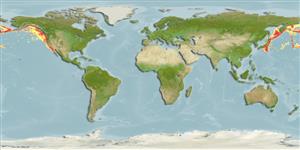>
Gadiformes (Cods) >
Macrouridae (Grenadiers or rattails)
Etymology: Coryphaenoides: Greek, koryphaina = dolphin fish + Suffix oides = similar to (Ref. 45335); acrolepis: From the Greek 'acros' meaning sharp and 'lepis' meaning scale (Ref. 6885).
More on author: Bean.
Environment: milieu / climate zone / depth range / distribution range
Ökologie
seewasser bathydemersal; standorttreu; tiefenbereich 300 - 3700 m (Ref. 50550), usually 900 - 1300 m (Ref. 56476). Deep-water; 1°C - 4°C (Ref. 1371); 62°N - 28°N, 134°E - 115°W (Ref. 1371)
North Pacific: northern Japan to Okhotsk and Bering seas, south along North American coasts to northern Mexico.
Length at first maturity / Size / Gewicht / Alter
Maturity: Lm 55.5, range 46 - 65 cm
Max length : 104 cm TL Männchen/unbestimmt; (Ref. 56527); common length : 46.9 cm TL Männchen/unbestimmt; (Ref. 56476); max. veröff. Gewicht: 3.0 kg (Ref. 56476); max. veröff. Alter: 73 Jahre (Ref. 35883)
Rückenflossenstacheln (insgesamt) : 2; Rückenflossenweichstrahlen (insgesamt) : 122; Afterflossenstacheln: 0; Afterflossenweichstrahlen: 94. Head large, scaled completely except for a narrow ventrolateral strip on snout; eyes also large; snout short, pointed and with tubercular scales along its leading edge; chin with a small chin barbel. Body tapering to a point posteriorly from behind the insertion of the first dorsal-fin spine. Scales adherent, with 3 to 5 divergent rows of coarse spinules. Pyloric caeca 12 to 14. Overall color is gray to grayish-brown in young, turning to dark brown in adults; fins generally dark. Branchiostegal rays: 6-6 (Ref. 36385).
A benthopelagic mid-slope species, that appears to wander off slope bottoms into midwater (Ref. 1371). Adults feed on small fish, euphausiids, prawns, amphipods and cephalopods (Ref. 1371). Oviparous, with planktonic larvae (Ref. 36385).
Cohen, D.M., T. Inada, T. Iwamoto and N. Scialabba, 1990. FAO species catalogue. Vol. 10. Gadiform fishes of the world (Order Gadiformes). An annotated and illustrated catalogue of cods, hakes, grenadiers and other gadiform fishes known to date. FAO Fish. Synop. 125(10). Rome: FAO. 442 p. (Ref. 1371)
IUCN Rote Liste Status (Ref. 130435: Version 2024-2)
Bedrohung für Menschen
Harmless
Nutzung durch Menschen
Fischereien: kommerziell
Tools
Zusatzinformationen
Download XML
Internet Quellen
Estimates based on models
Preferred temperature (Ref.
123201): 2.3 - 3.8, mean 2.4 °C (based on 174 cells).
Phylogenetic diversity index (Ref.
82804): PD
50 = 0.5000 [Uniqueness, from 0.5 = low to 2.0 = high].
Bayesian length-weight: a=0.00141 (0.00084 - 0.00236), b=3.19 (3.04 - 3.34), in cm total length, based on LWR estimates for this species & (Sub)family-body (Ref.
93245).
Trophic level (Ref.
69278): 3.8 ±0.54 se; based on food items.
Generation time: 45.8 ( na - na) years. Estimated as median ln(3)/K based on 2
growth studies.
Widerstandsfähigkeit (Ref.
120179): sehr niedrig, Verdopplung der Population dauert mehr als 14 Jahre. (K=0.02-0.04; tmax=73).
Fishing Vulnerability (Ref.
59153): Very high vulnerability (79 of 100).
Nutrients (Ref.
124155): Calcium = 11.1 [5.3, 31.5] mg/100g; Iron = 0.291 [0.136, 0.661] mg/100g; Protein = 16.4 [14.6, 18.1] %; Omega3 = 0.203 [0.082, 0.497] g/100g; Selenium = 33.6 [11.1, 135.0] μg/100g; VitaminA = 9.83 [1.59, 61.63] μg/100g; Zinc = 0.42 [0.24, 0.75] mg/100g (wet weight);
